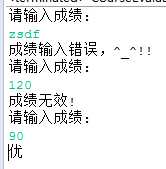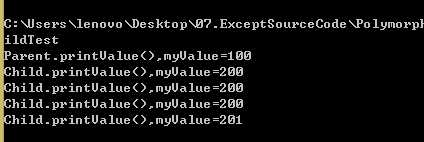标签:
1、编写一个程序,此程序在运行时要求用户输入一个 整数,代表某门课的考试成绩,程序接着给出“不及格”、“及格”、“中”、“良”、“优”的结论。要求程序必须具备足够的健壮性,不管用户输入什 么样的内容,都不会崩溃。
import java.util.Scanner; public class CourseEvaluation { public static void main(String[] args) throws Exception {//抛出异常信息 int n = 0; while(n!=1) { System.out.println("请输入成绩:"); Scanner c = new Scanner(System.in); String str = c.nextLine();//对出入的数据进行读取 try { double score = Double.parseDouble(str); //把输入的值转化成INT类型 if(score >= 0 && score < 60){ System.out.println("不及格"); n=1; } else if(score >= 60 && score < 70){ System.out.println("及格"); n=1; } else if(score >= 70 && score < 80){ System.out.println("中"); n=1; } else if(score >= 80 && score < 90){ System.out.println("良"); n=1; } else if(score >= 90 && score <= 100){ System.out.println("优"); n=1; } else{ System.out.println("成绩无效!"); } } catch(NumberFormatException e) { System.out.println("成绩输入错误,^_^!!"); }//捕捉错误 } } }

2、示例ParentChildTest.java
代码:
public class ParentChildTest { public static void main(String[] args) { Parent parent=new Parent(); parent.printValue(); Child child=new Child(); child.printValue(); parent=child; parent.printValue(); parent.myValue++; parent.printValue(); ((Child)parent).myValue++; parent.printValue(); } } class Parent{ public int myValue=100; public void printValue() { System.out.println("Parent.printValue(),myValue="+myValue); } } class Child extends Parent{ public int myValue=200; public void printValue() { System.out.println("Child.printValue(),myValue="+myValue); } }
验证截图:

总结:当子类与父类拥有一样的方法,并且让一个父类变量引用一个子类对象时,到底调用哪个方法,由对象自己的“真实”类型所决定,这就是说:对象是子类型的,它就调用子类型的方法,是父类型的,它就调用父类型的方法。这个特性实际上就是面向对象“多态”特性的具体表现。
如果子类与父类有相同的字段,则子类中的字段会代替或隐藏父类的字段,子类方法中访问的是子类中的字段(而不是父类中的字段)。如果子类方法确实想访问父类中被隐藏的同名字段,可以用super关键字来访问它。
如果子类被当作父类使用,则通过子类访问的字段是父类的!
3、请阅读并运行AboutException.java示例
截图:

4、阅读以下代码(CatchWho.java),写出程序运行结果:
验证截图:

5、写出CatchWho2.java程序运行的结果
验证截图:

6、请先阅读 EmbedFinally.java示例,再运行它,观察其输出并进行总结。
代码:
public class EmbededFinally { public static void main(String args[]) { int result; try { System.out.println("in Level 1"); try { System.out.println("in Level 2"); // result=100/0; //Level 2 try { System.out.println("in Level 3"); result=100/0; //Level 3 } catch (Exception e) { System.out.println("Level 3:" + e.getClass().toString()); } finally { System.out.println("In Level 3 finally"); } // result=100/0; //Level 2 } catch (Exception e) { System.out.println("Level 2:" + e.getClass().toString()); } finally { System.out.println("In Level 2 finally"); } // result = 100 / 0; //level 1 } catch (Exception e) { System.out.println("Level 1:" + e.getClass().toString()); } finally { . System.out.println("In Level 1 finally"); } } }
结果截图:

总结:
当有多层嵌套的finally时,异常在不同的层次抛出 ,在不同的位置抛出,可能会导致不同的finally语句块执行顺序。
7、请通过 SystemExitAndFinally.java示例程序回答finally语句块一定会执行吗?
验证截图:

总结:
不一定会执行,如果一个方法内在执行try{}语句之前就已经return了,那么finally语句指定不会执行了。因为它根本没有进入try语句中, 如果在一个try语句中调用System.exit(0);方法,那么就会退出当前java虚拟机,那么finally也就没有执行的机会了。
8、通过 PrintExpressionStack.java示例总结:
当程序中出现异常时,JVM会依据方法调用顺序依次查找有关的错误处理程序。
可使用printStackTrace 和 getMessage方法了解异常发生的情况:
printStackTrace:打印方法调用堆栈。
每个Throwable类的对象都有一个getMessage方法,它返回一个字串,这个字串是在Exception构造函数中传入的,通常让这一字串包含特定异常的相关信息。
标签:
原文地址:http://www.cnblogs.com/lk0823/p/4965158.html